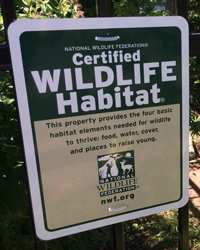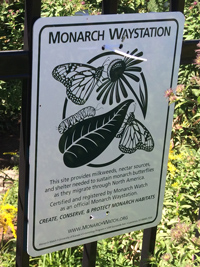story and photos by Michelle Sutton
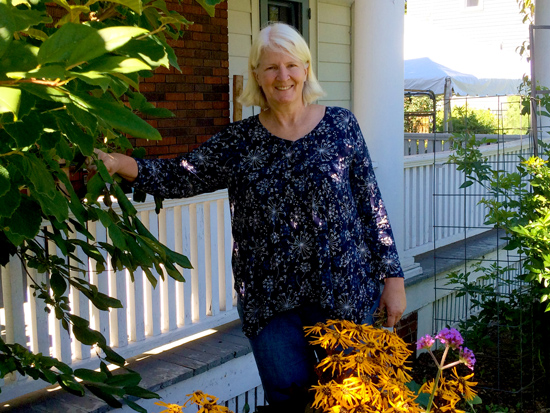
Carol Bradford in her element
Many of you will know garden writer Carol T. Bradford from her column in the Syracuse Post-Standard. She penned it twice a week from 1993 to 2016, contributing additional home and garden features along the way. Upon retirement from that publication, she calculated that she’d written the equivalent of twenty novels for it!
Bradford’s writing is succinct, pragmatic, and accessible. In the Post-Standard column (available online) called “Acid Soil is Made from Granite and Shale Bedrock,” she conveys a great deal about soils as they relate to gardening in six short paragraphs—no easy task. It exemplifies her talent as a communicator.
Carol Bradford and I first crossed paths in the early 2000s when as a graduate student I taught a Master Gardener class in greater Syracuse; Carol was part of the welcoming group that took me to dinner the night before. I’ve never forgotten how encouraging she was of me. I observed what a bright spirit she has and admired how knowledgeable and passionate about horticulture she is. So you can imagine my excitement when I had the chance to see her garden and ask her questions about her life and career thus far.
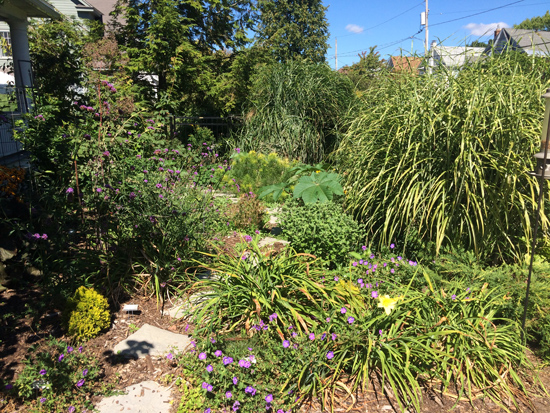
Come into the east-facing section of the Bradford Botanical Garden.

Take a peek in from the sidewalk. There are lots of native plants, but not exclusively.
INTERNATIONAL HABITATS
Bradford’s father was a bank officer who took assignments around the world. Her family lived in New York City, Florida, Arizona, and Massachusetts; Caracas, Venezuela; Geneva, Switzerland; Paris, France; Casablanca, Morocco; and Monrovia, Liberia. “As you can imagine, I saw all sorts of plant habitats,” she says. “I was fascinated by the flora in all these places.”
There’s another reason for her strong affinity for gardening. “My parents never required us kids to weed their gardens or pick rocks,” she says, “so as adults my two brothers and I were free to gravitate toward horticulture on our own accord. By contrast, my husband and his siblings, who did have to weed their family gardens, don’t care for gardening now.”
Bradford’s first gardens were vegetable and herb gardens she planted as a teenager in France. She was studying at the Cordon Bleu (as one does—no big deal) (!) and wanted to have fresh veggies to cook. Back in the States she went to Cornell, studying nutrition—but gradually realized she didn’t want to be a dietician after all. In her last semester she took Vegetable Crops 103 and found it thrilling. When she went to grad school in molecular biology and biochemistry at Syracuse University, she kept growing her own vegetables for cooking.
Bradford’s grad school studies revolved around Drosophila (fruit flies): their life cycles, anatomy, and so on. Bradford thinks this training helped her later when answering questions from home gardeners about insects. “People didn’t realize that most of the bugs they were seeing on the plants were innocent bystanders,” she says. “The true offender insects were long gone by the time folks noticed damage to the plant.” Readers would send Bradford bugs in the mail; she’d open the envelopes to find little piles of dried-out bug parts—ah, the glamorous life of a garden writer!
After grad school Bradford worked in a research lab doing environmental analysis of pesticides and writing environmental impact statements about them. What she learned about pesticides also came in handy for her garden writing career. Also, writing so many impact statements helped Bradford hone her technical writing skills.
Eventually Bradford’s first son was born and she decided to stay home with Andrew (and eventually younger son Tim), and she took the Onondaga County Master Gardener course. “I’ve always been a problem solver and I’m very linear so I was good at figuring out the steps to recommend to people who called Extension with their gardening challenges,” she says.
It was Horticulture educators at CCE who recommended the Post-Standard hire Bradford for the garden column. The letters rolled in. “So often readers had most of the facts but they didn’t have some critical piece of info that would enable them to put it all together,” she says. “It was thrilling when I could help find that piece.”
GARDEN TRAVELS
(Note to Reader: Prepare for Extreme Envy)
Bradford is at home in airports. She says she loves to travel because she did so much of it as a child. Among the many public and private gardens she’s visited in Europe, East Ruston Old Vicarage in Norfolk, England is her favorite (check it out online). “It’s a series of garden rooms, it’s incredibly creative, and the guys have attended cleverly to every detail,” she says.
In England, she’s also been to garden writer Beth Chatto’s garden (Bradford
got to meet Chatto, who was in her 90s), Sissinghurst, Great Dixter, Kew Gardens, the Blooms of Bressingham garden center and display gardens, the University of Cambridge Botanical Garden, and the exotic tropical garden of the late Will Giles. As a longtime member of the Royal Horticultural Society, Bradford has visited RHS Wisley Gardens and RHS Hyde Hall, the Chelsea Flower Show, the Hampton Court Palace Flower Show, and the Tatton Park Flower Show, and she hopes to visit the newest Flower Show at Chatsworth next year.
In Wales, Bradford loved Bodnant Gardens. She’s been to the famous Floriade, a World’s Fair for horticulture, held only every ten years in the Netherlands, to Keukenhof to see the annual Dutch bulb industry trade show, and to De Tuinen van Appeltern, the inspiring
Dutch idea garden. She went to Powerscourt Estate and to Helen Dillon’s famous walled garden in Dublin, Ireland before it closed. She has toured famous public and private gardens in China and Japan.
In the United States her favorite public garden among the dozens (hundreds?) she’s seen is Chanticleer. Her favorite New York public garden is the New York Botanical Garden, and she was totally blown away by the High Line. She’s ever-impressed by Cornell Botanic Gardens and thinks Sonnenberg Gardens has huge potential. She loves the Royal Botanical Gardens in Hamilton, Ontario (“that’s an easy day trip from here”), the neighborhood gardens featured at Garden Walk Buffalo, and the PepsiCo Sculpture Gardens in Purchase. She hopes someday to get to the West Coast to visit Ganna Walska Lotusland and the Japanese Garden in Portland.
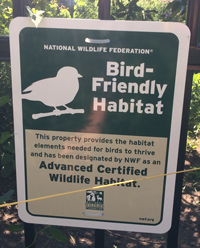

A banner year for Nicotiana sylvestris volunteers
BACK AT THE BRADFORD BOTANICAL GARDEN
Bradford has more than 400 kinds of plants in her garden, many of which are labeled with the help of a Brother P-Touch Label Maker and zinc plant markers; she says she’d do stainless steel markers in future because they’re more durable and would better resist trampling by her two dogs. In terms of records, she keeps a spreadsheet for seasonal bloom. “I like to have flowers 12 months a year,” she says. (In Syracuse, hellebores provide the flowers for the deepest winter months.)
A pond went in several years ago (“I love it so much, I wish I had put it in sooner”) and a garden was built around that. “At first I was going to use only native plants for the pond itself but I got seduced by the tropical water lilies and such,” Bradford says.While natural pond edges are soggy, constructed liner-based ponds tend to be quite dry on their perimeters, outside their liners. There, Bradford has planted drought-tolerant things like prickly pear cactus, succulents, alliums, and lewisias.
Bradford grows a great many food crops including peaches and apples. “Unfortunately, last spring we had a bizarre spring temperature drop of fifty degrees and the flowers got zapped; it was the first year since they started fruiting that the apples and peaches didn’t bear a fruit.” It was a challenging season all around— drought and high temps, and
powdery mildew was “on everything.” She also grows small fruits including gooseberries and black and white currants. And of course, she has a large veggie garden. Last year she had fun trying out the new currant tomato ‘Candyland’.
In a nod to the famous White Garden at Sissinghurst, Bradford has her own white garden. It contains Japanese hydrangea vine (Schizophragma ‘Moonlight’) growing on an apple tree; ‘Honorine Jobert’ anemone (a cultivar of Anemone x hybrida and the Perennial Plant of the Year in 2016); ‘Royal Standard’, ‘El Niño’, and ‘Praying Hands’ hosta; white-flowered bleeding heart (Dicentra spectabilis ‘Alba’); bugbane (Cimicifuga spp.); goatsbeard (Aruncus dioicus); Clematis ‘Paul Farges’; Japanese painted fern (Athyrium niponicum); a white-flowered pulmonaria called ‘Sissinghurst’; and a white-blooming swamp milkweed (Asclepias incarnata). There’s even a dove tree (Davidia involucrata), the tree whose flowers look like white handkerchiefs, which is not reliably hardy in Syracuse and hasn’t flowered in fifteen years…but hope springs eternal.
Speaking of white flowers, last year Bradford was delighted with volunteer Nicotiana sylvestris that sprung up all over. It’s a plant that is fragrant at night and hardly open during the day. “I bought the plants a few years ago and for a season they didn’t reappear, but then one summer one plant appeared, and then last summer they were everywhere—I just love them.” She hopes they are naturalizing in her yard to stay.
All of Bradford’s plants have stories connected to them. She has a Japanese maple, Acer palmatum ‘Toyama Nishiki’ that she planted in honor of her daughter-in-law Ai, who is Japanese. A hosta called ‘Andrew’ brings to mind her older son. Her ‘Julia Child’ rose reminds her of her time studying at the Cordon Bleu as a teenager (no big deal!)…and so on.
Michelle Sutton (michellejudysutton.com) is a horticulturist, editor, and writer.
Views: 39





